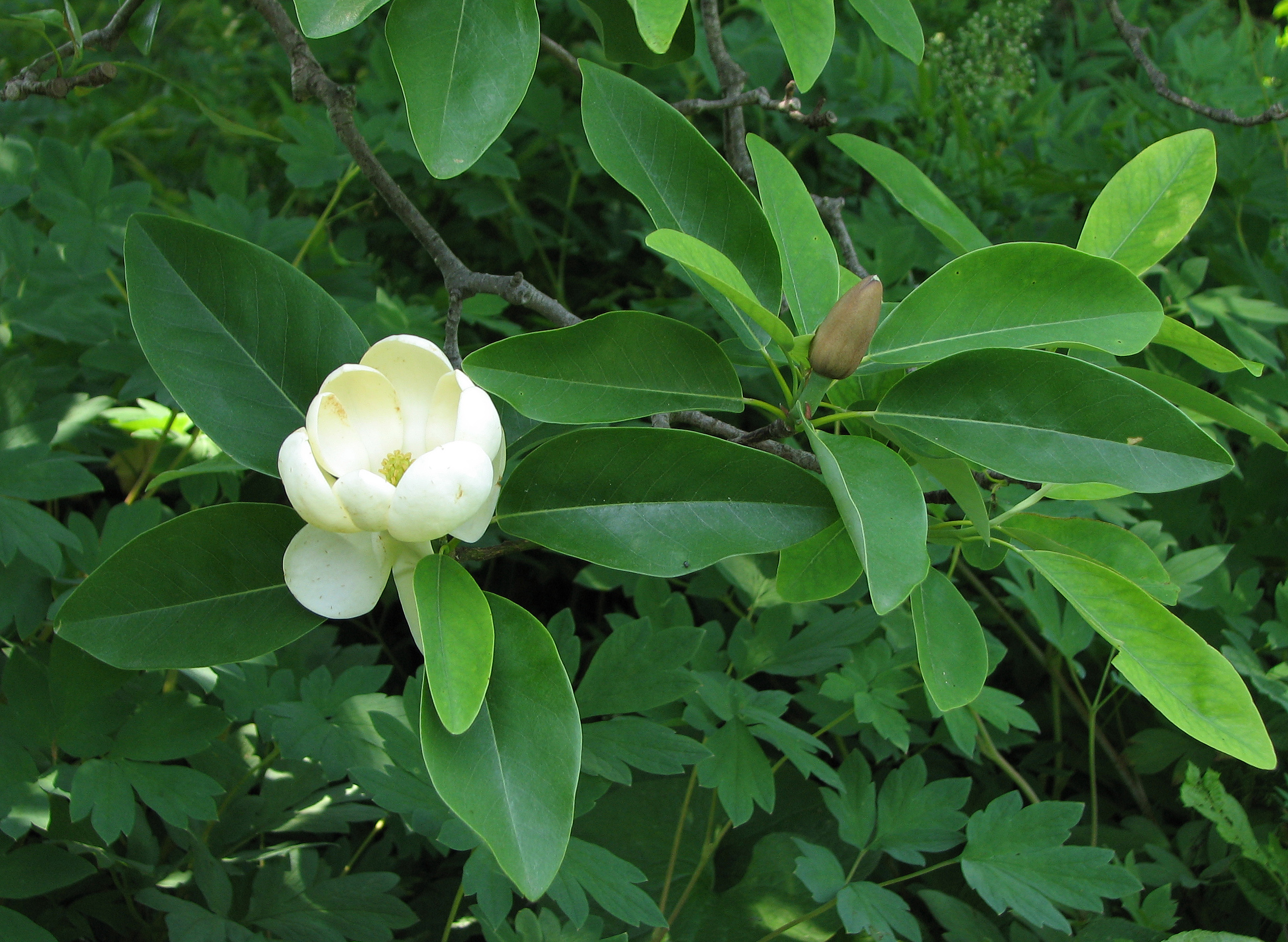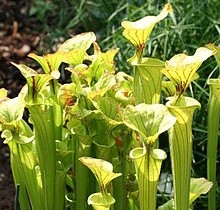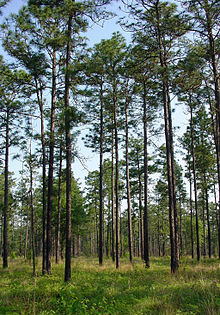Unique Habitats
Baygalls - Important scrub-shrub or forested wetlands that may contain trees like Red Maple (below left), Sweetbay Magnolia (below right), and Black Gum and many ferns, like Netted Chain Fern, and Tall Inkberry Holly (Gallberry Holly). Baygalls are an indicator of groundwater seepage or springs.


 Bogs - Home of herbaceous wetland carnivorous plants like Yellow Pitcher Plant (right), Bog Violet, bladderwort species, and sundew species. Cinnamon and Royal Fern are also frequently present in bogs. Open conditions with a lot of sunlight are needed or these sun-loving species will wither in shaded conditions.
Bogs - Home of herbaceous wetland carnivorous plants like Yellow Pitcher Plant (right), Bog Violet, bladderwort species, and sundew species. Cinnamon and Royal Fern are also frequently present in bogs. Open conditions with a lot of sunlight are needed or these sun-loving species will wither in shaded conditions.

Longleaf Pine Forests - Longleaf Pine (left) woodlands, wetlands, and savannahs are located on well-drained, sandy soils or on flat areas with a hard claypan (Longleaf Pine Savannah Wetlands) where water is retained. Longleaf Pines are slow-growing trees. They take 100 to 150 years to reach maturity and can live up to 500 years. Furthermore, these trees are preferred by the endangered Red-Cockaded Woodpecker. Unfortunately, due to overharvesting and the longleaf pine’s extended growth period they now occupy only about 5% of their pre-colonization range and are considered endangered. Longleaf pine is frequently found with Little Bluestem Grass.
Dry-Xeric Oak-Pine Forests - These forests are usually found on dry, sandy, upper to mid slopes with Shortleaf Pine, Loblolly Pine and Longleaf Pine and Bluejack Oak, Blackjack Oak, and Black Hickory.
Upland Pine-Oak Forests - Longleaf, Shortleaf, and Loblolly Pine trees grow in association with Southern Red Oak, White Oak, and below that, Flowering Dogwood (below left) and Redbud (below right).


Mesic Oak-Pine Forests - These forests can be dominated by White Oak with Southern Red Oak and Mockernut Hickory (right) in association with Shortleaf and Loblolly Pine trees on the mid slope. They may also have Slender Wake Robin, Carolina Violet, Mayapple, and Flowering Dogwood below the canopy.
Southern Red Oak and Mockernut Hickory (right) in association with Shortleaf and Loblolly Pine trees on the mid slope. They may also have Slender Wake Robin, Carolina Violet, Mayapple, and Flowering Dogwood below the canopy.
Mesic Hardwood Forests - Loblolly Pine, Southern Magnolia, and American Beech, which is found along small streams, provide dense shade and limited ground cover on the lower slope. Southern Cranefly Orchid, Sebastian Bush, and Christmas Fern are found here.
Bottomland Hardwood Forests - A variety of hardwood trees are found here including Cherrybark Oak, Sweetgum, Black Willow, Green Ash, American Elm, Texas Cedar Elm, and many others. Bald Cypress and Water Tupelo Swamps are also found in bottomlands along with many floodplain features.
Blackland Prairies - Characterized by deep, dark-gray or alkaline (basic, pH>7) black clay that is known as “cracking clay” because large, deep cracks can appear in the clay during dry weather. Blackland prairie lands are found scattered in the western, northwestern and central parts of Sam Houston National Forest. Many wildflowers, such as Texas Bluebell, Purple Prairie Clover and Rattlesnake Master can be found in the Blackland Prairies.
Rare and Interesting Species
The Louisiana Pine Snake is recognized as one of the rarest snakes in North America and one of the rarest vertebrate species in the United States. Angelina and Sabine National Forests are two of the three locations in Texas where pine snakes have been found. Habitat loss, fire suppression, and vehicle-snake collisions are believed to be the primary causes for the Louisiana Pine Snake’s population decline over the last 50 to 80 years. For more visit the U.S. Fish and Wildlife information page.
vertebrate species in the United States. Angelina and Sabine National Forests are two of the three locations in Texas where pine snakes have been found. Habitat loss, fire suppression, and vehicle-snake collisions are believed to be the primary causes for the Louisiana Pine Snake’s population decline over the last 50 to 80 years. For more visit the U.S. Fish and Wildlife information page.
The Sabine River Wake-Robin is a member of the lily family found exclusively along the Sabine River. This plant takes years to become established and decades more to expand into a colony. They are a sign of an undisturbed forest. The Lady Bird Johnson Wildflower Center has more information.
 The Bald Eagle has come back from the edge of extinction! The national symbol of the United States can be found roosting in trees along the rivers in all four national forests in Texas. These forests are home to both resident and migratory Bald Eagles.
The Bald Eagle has come back from the edge of extinction! The national symbol of the United States can be found roosting in trees along the rivers in all four national forests in Texas. These forests are home to both resident and migratory Bald Eagles.
The Red-Cockaded Woodpecker is a federally-listed endangered species that can be found in all four national forests in Texas. These woodpeckers prefer pine trees that are more than 60 years old that are also infected with red-heart fungus disease. The fungus softens the inside of the pine tree, which makes it easier for the Red-Cockaded Woodpeckers to excavate a cavity within a living tree. Red-Cockaded Woodpeckers are the only species of woodpecker to create cavities in living trees. Habitat loss is the biggest threat to their survival. More information can be found on the U.S. Fish & Wildlife Service’s website.
are more than 60 years old that are also infected with red-heart fungus disease. The fungus softens the inside of the pine tree, which makes it easier for the Red-Cockaded Woodpeckers to excavate a cavity within a living tree. Red-Cockaded Woodpeckers are the only species of woodpecker to create cavities in living trees. Habitat loss is the biggest threat to their survival. More information can be found on the U.S. Fish & Wildlife Service’s website.
Image Credits: Lilla Frerichs, Ram-Man and Chanticleer Garden, Jean-Pol GRANDMONT, The Bugwood Network, At Home Memphis & Mid-South, Hoodedwarbler12, Augustana.gov, Andrew Dunn, Richard Thomas- NPS, Crazytwoknobs, Daniel Saenz- FS, Lady Bird Johnson Wildflower Center (Loughmill, Campbell and Lynn), Saffron Blaze, Fish and Wildlife Service